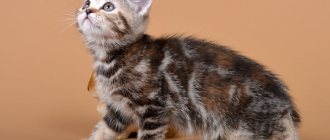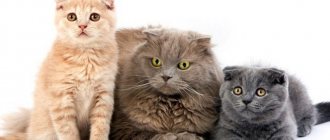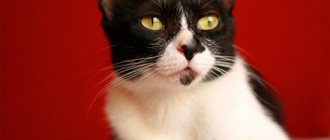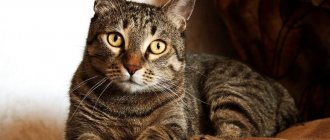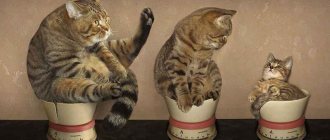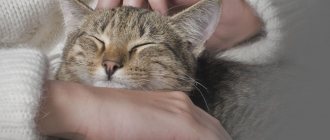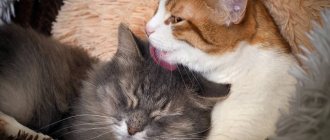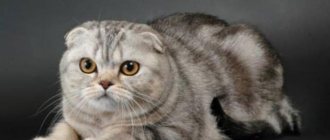Persian cats are very common on the planet. This is one of the most beautiful breeds among domesticated cats. But they attract people not only with their appearance and increased level of fluffiness, but also with minimal activity and playfulness. These are “sofa” aristocrats who will not run around the house and tear off wallpaper in a fit of playful insistence. Persians prefer the monotonous royal recumbent pastime and, moreover, hate loneliness. They are sincerely attached to the owner and accompany him even during sleep, resting with him in the same bed.
Persian longhair breed
| Breed name | Persian longhair cat (Persian) |
| Path of occurrence | Aboriginal breed with further development |
| Country of origin | Armenia, Iran, Türkiye |
| Coat | Longhair |
| Lifespan | 15 – 20 years |
| Cost of a kitten | 5 – 15 thousand rubles. |
History of the origin of the Persian breed
Special cats with thick fur appeared in Persia, which is why their name appeared when Pietro della Valle, a traveler from Italy, came to the Middle East in the 17th century. It is he who should be thanked for the appearance of the Persians - he brought animals with large ears and a straight long nose to Italy.
Other mentions were made a hundred years later, when the French biologist Georges-Louis Leclerc described them in his writings. The engravings found show the similarity of Persian cats with Turkish Angoras - the ears are widely spaced, the nose is short, snub-nosed, and the skull is wide. In addition, some scientists assumed that cats could have appeared in Rus' and called them Russians, since it was in harsh cold conditions that they could acquire their thick fur.
Breeders became interested in Persian cats already in the 19th century, when in Great Britain they set out to change the appearance of cats. At an exhibition in 1887, Persian cats as we used to know them were recognized for the first time as a separate breed.
Persians began to gain their popularity at the end of the 19th century, when they were brought to the United States. Over time, after American modernization, a new type appeared - extreme Persians - the nose shortened and is approximately at eye level.
I consider Persian cats to be truly royal - their beautiful, flowing fur, sweet face and calm character have made this breed the most in demand.
Does wool get in the way? It needs to be shortened!
This is exactly what breeders probably thought when they started breeding short-haired Persians. Indeed, long hair requires careful care and causes inconvenience to furry owners. Therefore, a variety of the breed was developed - exotic shorthair (abbreviated as exotic). Cats have inherited genetic diseases of Persians, their head and nose structure, but the fur of these animals is much shorter.
Exotic shorthair cat
Description of the breed
Persian standard
There are currently 4 main types of Persian cats recognized:
- The classic type (British) is outdated, with a noticeable nose, the edge of which is located 5-6 mm below the edge of the inner corner of the eye.
- Modern type (short nose) - have an open look, the bridge of the nose is raised. Thanks to the wide eyes, the nasolacrimal ducts are not deformed, and the animal does not have a gloomy expression on its face.
- Extreme type (American) - the breed description is characterized by a short nose, round forehead, low-set ears, and straight-set eyes. The earlobe is almost at the same level with the inner corner of the eyes.
- Pig type (piggy) - the convexity of the skull is almost not pronounced, low weight, weak bones. This type is derived from the extreme.
classical
modern
extreme
pig type
Regardless of the type, the following standard characteristics are distinguished:
- Body: massive but compact; the chest and stomach are wide, rounded; the tail is proportionally short, very fluffy; average weight for females is 3-4 kg, for males 5-6 kg.
- Coat: silky, soft long hair covering the entire body; There are more than 200 species of Persian cat colors, including the graceful white Persian chinchilla.
- Head: muzzle flattened, almost flat, bone wide; forehead is rounded; the nose is short and raised.
- Eyes: wide-set, large and expressive; eye color can be green, blue, brown, and can also differ from one another (colorpoints with blue eyes and chinchillas with green should be noted separately); friendly look.
- Ears: usually small, low set, rounded tips; hidden behind abundant fur.
- Limbs: paws are fluffy, thick, proportionally short relative to the body.
- Life expectancy: extreme Persians live up to 15 years, ordinary modern Persians under normal conditions can live on average up to 20 years.
Colors
- Solid (solid) - solid colors: white, black, blue, red (red), lilac, cream, chocolate. There are no patterns or streaks on the wool. Eye color is most often copper and dark orange or dark blue in white Persians.
- Bicolor is a combination of a primary color and white. The color of Persians is rare for Russian exhibitions, since breeding such a capricious spotted color requires a lot of effort. Bicolors should have at least 1/2 and no more than 2/3 white in color, with white spots on the head and tail desirable.
- Tabby - patterns on the fur: stripes, spots and marbles. Any basic coat color.
- Color point is the so-called Siamese coat color with dark spots on the face, paws and tail. Popular colors include brown, lilac, blue and black spots. Persian color-pointed cats were even identified as a separate breed - the Himalayan cat.
- Smoky is an amazing color in which each hair is conventionally divided into 2 color parts: a light base at the root and a dark color at the tip - tipping. At rest, the cat appears monochromatic, but when moving, the light undercoat becomes visible. Shades: black smoky, blue smoke, chocolate, tortoiseshell, lilac.
- Chinchilla - Golden and silver Persian chinchillas are now considered very popular and popular colors of the breed. Black tipping (the hair is colored only 1/8 with a dark tip) is evenly distributed on the back, sides, head and tail. The main color of gold is light apricot, while that of silver is pure white. A characteristic feature of chinchillas is the black rim around the eyes, nose and lips.
- Tortoiseshell is the color of Persian cats, in which there is a combination of two primary colors at once - red and black or their lightened analogues - cream and blue. This also includes the calico - a combination of tortoiseshell and white.
Tortoiseshell color: what does it mean?
Not all calico cats are called tortoiseshells. Animals whose colors contain three colors (usually white, red and black) are called tortoiseshells only when multi-colored hairs are mixed together and create a motley small pattern. If a cat’s spots are large and have clear boundaries, this color is called tricolor, which, in fact, means a color that includes three colors.
Curiously, only cats are tricolor or tortoiseshell. This is due to a specific genetic code, and the fair half of the cat family has completely taken away the right to be variegated from the strong one. Tortoiseshell calico cats are rare - one in several thousand, and, as a rule, these animals are sterile from birth, that is, they cannot give birth.
Tricolor cat
How do cats get tortoiseshell coloration?
The color of a cat's fur and the pattern on it are determined genetically, that is, before the kitten is born. Mother cats have a set of two chromosomes - XX, while cats "got" only one X chromosome, the second - Y. The "X" chromosome is responsible for the black and peach-red color, so in addition to snow-white fur, cats may develop both charcoal and orange. Accordingly, the only X chromosome in cats, in addition to white, can give them either black or red, but not at the same time.
That is, the sex of an animal is determined by a pair of chromosomes: XX - cat, XY - cat. The black and red colors of a cat's coat are determined by the genes of the sex chromosomes. The Y chromosome, which is smaller in size, does not contain genes for black(o) or red(O) color. If we consider a cat (that is, an XY individual), then the game does not contain information about color, and the claim will contain either a red tint (O) or a jet black color (o). Accordingly, the chromosome can contain only the shade of fur of one variant.
Having seen a tortoiseshell cat, a person can know exactly what gender it is.
In a cat (XX individual), there are more color variations, since the first X can carry the red gene (O), and the second X can carry the black gene (o). That is, the combination of XO and Xo will give exactly the tortoiseshell color.
It turns out that only cats are genetically inclined towards the tricolor color. The tricolor cat is a real anomaly, which neither scientists nor feline breeders can explain. Unfortunately, tortoiseshell cats have violations of the genetic code, suffer from pathologies of the endocrine and reproductive systems, and rarely live beyond two or three years.
Video - How is tortoiseshell coloration inherited in cats?
Gallery of photos of Persian cats
Solid colors
red
black
white
blue
lilac
chocolate
Bicolor - two-color
red bicolor
black bicolor
Blue bicolor
Lilac bicolor
Tabby
red tabby
black marble
brown tabby
golden tabby
red marble
Color point and smoky
black smoke
blue smoke
chocolate smoke
color point
color point
Chinchillas and turtles
golden chinchilla
silver chinchilla
tortoiseshell
calico
Types of tortoiseshell cats
The tortoiseshell color of a cat can cover the entire body or appear as a separate pattern. It is impossible to find identical variants, so they are often compared to human fingerprints. Despite this, felinologists highlight some characteristic features. Based on them, all turtle cats are divided into 3 varieties.
Torti, or scaly
This coloring resembles shiny fish scales. Small black and red spots are located in a chaotic order on the fur coat of a tortoiseshell cat. They do not have clear boundaries and symmetry, but the percentage of primary colors is always approximately the same.
Calico, or patchwork
The second variety is called calico. Cats with this tortoiseshell color look like they are wrapped in a patchwork quilt. Most of their body is painted white, and the rest is covered with multiple multi-colored spots that overlap each other.
Marble
Sometimes the tortoiseshell color of a cat is arranged in an unusual pattern, similar to marble. This combination is very rare, and is more often found in purebred cats.
Health
The lifespan of Persian cats is one of the longest - with a loving owner and favorable living conditions, a cat can live more than 20 years.
Unfortunately, these cats are predisposed to hereditary diseases. Among the most popular and frequently encountered are:
- Bladder stones.
- Polycystic kidney disease.
- Cystitis.
- Congenital liver problems.
- Progressive retinal atrophy.
If any symptoms occur, treatment and even surgery are necessary. That is why potential buyers are advised to be very careful when choosing a breeder to purchase a kitten; they need to carefully check the pedigree and make sure that there have been no previous cases of the disease.
Pros and cons of the Persian breed:
Persians act in films
The Persians have their place in history and on the silver screen. In addition to the well-known Fancy Feast mascot, James Bond's nemesis Blofield had a grizzled, blue-eyed Persian companion.
And, let's not forget, Mr. Bigglesworth, of Austin Powers fame. (In a slight plot twist, the Persian version of Mr. Bigglesworth was replaced by a hairless sphinx cat for the rest of the film.)
Character of the Persians
The obedient Persian is known for being quiet and sweet most of the time. They are affectionate and picky, they give all their attention to their owner, but at the same time they are wary of house guests.
Important! Persian cats make excellent companions for their owner's family - they are calm and do not fuss unreasonably.
The Persian cat's personality is very calm; loud environments are frowned upon. Their usual needs and activities include eating, playing with toys, and napping during the day. And the most important thing for them is a lot of love, which a caring owner will be able to give to her by carefully combing her fur.
Such cats are unlikely to jump on your curtains or chew your wallpaper. While the family is not at home, the quiet cat prefers to be the decoration of the chair, waiting for his evening portion of care.
How to cope with loneliness
Nature created cats with bright personalities. Despite the fact that they are attached to their owner and need to communicate with him, they remain self-sufficient. The Persian cat spends most of its time in a relaxed state, lounging on a soft sofa. Due to their phlegmatic disposition and inactivity, Persian cats are called interior cats.
Being alone for several hours will not be a serious stress for them. Having a sufficient amount of food in stock, the pet can easily wait for its beloved owner to get home from work. Upon returning, the owner must make amends: talk tenderly to the pet, accompanying the conversation with strokes.
If a longer absence from the owner is required, careful preparation is required. The animal should be safe and not feel abandoned and forgotten. The preparation points are:
- leave enough food and water;
- purchase an additional tray;
- close windows and vents, turn off taps and burners;
- instruct a friend or relative to come every day to feed, clean the tray and communicate with the pet.
Differences in appearance and character: Persian, British Longhair and exotic
| Persian cat | British longhair cat | Exotic shorthair cat | |
| Peculiarities |
|
|
|
| Character |
| isolated and independent, calm temperament | calm, affectionate and friendly character |
| Difficulties |
|
| Grooming does not require much effort and time; dense wool does not need to be combed frequently |
| Dimensions | Average weight 3-5 kg, male 4-6 kg | Average weight 4-7 kg | The average weight of females is 5 kg, males up to 7 kg |
| Nutrition | Many prohibited foods due to digestive characteristics | The amount of food should be strictly measured, prone to overeating | They are demanding on the diet, most often they use specialized industrial feed of super-premium class and higher |
Pros and cons of the breed
Persian cats are valued for their friendly and easy-going nature. A phlegmatic temperament is regarded by many as an advantage, because thanks to their calm disposition, pets easily adapt to the proposed living conditions and get along with other four-legged inhabitants of the apartment. They do not strive for dominance, are not annoying, but happily accept affection. If the owners are busy, they calmly experience these moments.
The Persian cat is suitable for families with children: it is not aggressive, patient, and will not release its claws or bite when playing.
The undoubted advantage of the Persian is its attractive appearance, harmonious build, and extraordinary richness of colors.
Among the most significant disadvantages of the breed is a significant number of breed hereditary pathologies. The Persian cat is fastidious in its care. The owner will have to spend a certain amount of time every day tidying up the pet’s coat. The Persian is one of the most allergenic breeds, which must be taken into account by sensitive people.
Possible problems
The Persian breed is considered quite whimsical, so it is not recommended to have such a cat for constantly busy people: after all, additional time is required to care for the coat
It is not recommended to have a cat of this breed if there are many children in your house, but they will be very happy with the tender and affectionate attention of children.
Important! Persian cats contain a lot of allergenic protein and spread it very actively, which is why they are considered one of the most dangerous breeds for allergy sufferers. Increased shedding, watery eyes and nasal discharge are dangerous.
Persians are very domesticated and affectionate animals, so it is quite difficult for them to get along with other cats or dogs. Also, it is not recommended to let them go outside, as their fur is very difficult to clean from debris or leaves.
Persians have incredibly thick fur
Another distinctive feature of the Persians is their long, luxurious hair. Consisting of two layers of coat - a shorter undercoat and a long, silky topcoat - Persian coats tend to shed heavily.
If you're thinking about getting a Persian, or you already have a Persian and are buried in cat hair, here's our advice: Get a vacuum cleaner specifically designed to suck up cat hair, place a few strategically hidden lint rollers around your home, and stop wearing black.
Care
The Persian cat can rightfully be called one of the most demanding of attention and care. What requires most attention is a chic fur coat and a balanced diet.
Wool
The most important thing in caring for a Persian cat is to understand that he will need daily care. This long, beautiful coat by itself cannot remain clean and tangled: tangles of the undercoat can form very quickly, which causes great inconvenience to the animal, and it is very difficult to comb them out.
The pet must be gently but thoroughly combed every day, first soothing it with smooth strokes, and then carefully combing it with a special long-toothed brush according to the hair growth. At the end of the procedure, you need to use a spray with an antistatic effect.
Advice! A good purchase would be a furminator - a special comb-trimmer with frequent metal teeth, which will ease the spring-autumn periods of shedding in Persians.
Bathing is not the most favorite procedure for cats, so the optimal frequency is once a month. After washing to dry, it is better to use a hairdryer on low power to avoid drafts and the likelihood of a runny nose and colds.
How to cut a Persian's hair is a very popular request; however, cats do not require a specialized haircut, but sometimes matted fur needs to be cut off. Grooming Persians can be a solution for owners and pets who live in hot and humid climates. For the summer period, the hair from the body is cut off, without affecting the head, tip of the tail and toes.
It is important to keep the litter box clean as droppings and litter pellets can get stuck in paws or on thick fur. If you don't clean it out scrupulously, the Persian may become stubborn and start shitting in the wrong place. Some Persian owners prefer to slightly shorten the hair between the toes, which reduces the problem.
Nutrition of Persian cats
Persians often have problems with the digestive tract, so their nutrition must be approached with particular seriousness.
The basis of their natural diet should consist of lean meat, which is given boiled, baked in the oven or even raw. Several times a week you can add organ meats or fish. In addition, cats also receive vegetables, most often boiled carrots, cauliflower or broccoli, zucchini and pumpkin. Be sure to add low-fat fermented milk products (yogurt, kefir, cottage cheese) to your animal’s diet.
If you decide to feed your cat natural food, then you need to additionally add age-appropriate vitamins and taurine to the diet.
Important! As an alternative, you can use ready-made food, but it is not recommended to choose manufacturers from the economy segment. What you feed your cat determines its lifespan.
Many experts believe that cats after castration are less active, eat more and begin to gain weight, but this is not entirely true. If you correctly calculate the daily ration and prepare a diet with a limited fat content, and also keep your cat busy with active games, then weight gain will not occur.
Advice! Buy stable, wide, but not very deep bowls for water and food so that your Persian is less likely to stain the hair on his face while eating.
Dry food for Persians
The Persian breed is so popular and numerous that special food is produced for Persians to maintain the beauty of the coat and its easy removal from the intestines. Popular brands:
- Royal Canin Adult Persian is a specialized food for Persians from Royal Canin.
- Pro Plan Optiderma Elegant – for healthy skin and coat.
- Grandorf Cat Indoor will not only help maintain the beauty of the coat, but will also reduce allergic reactions in cats with sensitive digestion.
- Orijen Cat 6 Fresh Fish - small granules of food are perfect for Persians with extreme stops, so cats will not need to open their mouths too much when eating. Origin belongs to the holistic class.
Caring for ears, eyes and claws
The ears should be cleaned with a cotton swab soaked in a special lotion once a week.
Since the eyes of Persian cats have specific tear ducts, they regularly secrete secretions, which is why the eyes often water. It is difficult to remove discharge without causing inconvenience to the cat, so dried crusts should be wiped with a cloth and eye care product.
Regular nail trimming is necessary for the animal; you can do this yourself using a nail clipper: you need to carefully cut off only the tip of the claw to avoid injury to the vessel inside.
Walking your pet
Persian cats are rarely taken for walks: they are calm in nature and do not want to go on a trip. It is enough for them to be in the space of the apartment, and they can watch everything that happens from an open window.
If the owner has a private house and prefers to let the cat outside, then experts recommend fencing off a section of the garden for him where he could spend time, but even in such conditions he must be constantly monitored. And don’t forget to treat your cats for ticks and worms, and for the summer, you can purchase a collar impregnated with an anti-parasite agent.
Owner reviews
- Svetlana. I have extreme-type Persians Timofey and Benjamin, who are completely different in character. If Tim is independent and does not need company at all, then Venya can be freely picked up and squeezed, he really likes it. Venya always needs communication. When Tim refuses to play with him, then I have to do it. Venya’s favorite toy is a ball of paper that you throw, and he will bring it back in his teeth. And Tima loves to tear up wallpaper, despite the fact that the house is full of scratching posts. Tim has been accustomed to dry food since childhood and does not recognize other food. And Venya loves yogurt, eats it with pleasure and slurps loudly with pleasure.
- Sergey. We have a cat of the Persian breed with beautiful, moderately thick hair of a smoky color. I never tire of admiring her: Marcy radiates calmness and friendliness with her entire appearance, which can be envied. She sleeps or walks around the house all day, watching what is happening. She has never scratched or bit anyone yet. In general, a real keeper of the house.
- Irina. We have a kitten, very fluffy and soft, but, oddly enough, he did not shed much either in summer or autumn. My special shampoo for kittens with long hair – Marsik likes it. As befits kittens, he is very active, playful and, which is not typical for Persians, loves to meow loudly. He often sleeps in a box so that no one can find him. Sometimes punctures happen: he walks past the tray. We are fighting this habit, but so far without success. We forgive him everything and love him more than anyone in the world!
How to choose a Persian kitten
First of all, you should pay attention to the purpose of the choice - if you want to participate in exhibitions, then the mother cat must be selected from a special club with a mandatory ideal pedigree and the cost will be correspondingly high. If the kitten is for home and for your soul, then you need to find out from the breeder about the type of breed, the health of the offspring, and the presence of diseases in its parents.
Advice! The breed type appears in the baby at about 2-4 months, this is the optimal time for choosing.
It is advisable to take the kitten out of its familiar environment so that you can assess its contact with other animals, find out whether it feeds itself and whether it is potty trained. A healthy kitten should show interest in everything around it, including you. He should be clean and his coat should be smooth.
The price of kittens varies depending on the type of cat and color; eye color is also important. The most expensive colors will be golden and silver chinchillas, solid (snow white, black), smoke and tortoiseshell calicos. On average, breeders offer to buy a two-month-old kitten for 5 – 15 thousand rubles.
blue kitten persian
gray bicolor
Breeding
Breeding purebred Persians is a big responsibility; it will take a lot of effort and money to start your own business. The choice of an ideal mating partner must be very serious, since only breeding cats are chosen for owners of high-breed cats.
But choosing the best individuals does not always lead to ideal offspring: kittens are often born with various defects in their appearance. Therefore, many breeders prefer a compensatory breeding method, in which both individuals have some defects in appearance, but are necessarily different.
If the owner has seriously decided to engage in crossing high-breed cats, then one should very carefully study all the possibilities of crossing non-ideal partners in order to establish the possibility of anomalies in the exterior and their transmission to offspring.
| Nursery name | City | Official website of the nursery |
| BAR'LAND RUS | Moscow | https://barlandrus.ru/ |
| LumiCat | Moscow | https://www.lumicat.ru/ |
| FLUFFY FLOCK | Moscow | https://fluffycat.ru/ |
| SNOW DREAM | Moscow | https://snow-dreams.ru/ |
| HELGA'S CAT | Saint Petersburg | https://helgas.name/ |
| MATIOLLA | Samara | https://matiolla.com/ |
Is it only cats?
There is a persistent myth that only cats can be carriers of tortoiseshell coloring - due to the fact that their sex chromosomes look like XX and make it possible for both black and red colors to appear simultaneously. It is not true. It is also not entirely true that, according to statistics, for every three thousand tortoiseshell cats, only one cat of this color is born - and that one is somehow sick, defective and practically sexless.
Tortoiseshell cat or tortoiseshell cat?
The quirks of nature are much more diverse and sophisticated than our understanding. Genetic solitaire games sometimes produce unpredictable results that are difficult to explain from a scientific point of view. For example, felinologists claim that the birth rate of tricolor cats directly depends on the region of their residence - scientists have not yet found an explanation for this phenomenon. But statistics on this matter, alas, are inaccurate—systematic studies have not yet been conducted.
Tortoiseshell cats
Contrary to popular belief, tortoiseshell - calico - cats do exist. But in order for the “female” color to appear, the cat must have a certain gene anomaly: the formula of their sex chromosome set is XXY. Such males are usually sterile, although there are exceptions.
One of the most famous calico cats was born in Germany in 2014, his name is Mesomix, he is a Maine Coon, and he is very fertile. The breeding nursery is rightfully proud of this phenomenon, from where Mesomix regularly travels for matings and examinations around the world. Scientists have found out that he is a chimera cat with an XY/XY chromosome set.
Tricolor Maine Coon Mesomix - the famous chimera cat
Quite a lot of tricolor chimera cats are known. They can be anatomically and behaviorally similar to cats, practically do not mark their territory, do not react to females in heat and, accordingly, do not give birth to offspring. Calico-colored cats are more common than “tortoises”; they are usually cryptorchids - but that’s a completely different story.
Friends of the Smith family from Great Britain vying with each other to say that happiness has come to their friends’ house since a calico cat named Jake settled there. Richard Smith promised his son a kitten as a gift, and together they went to choose a purchase. My son liked the bright calico-colored baby, and for some time the whole family was sure that they had bought a cat. Only a couple of months later, during an examination by a veterinarian, it turned out that they had made a unique acquisition - a tricolor cat. He was given a new name - Jake; The cat is absolutely healthy and cheerful. And since then, good luck has come to the Smith house.
Calico cat Jake brought good luck to his owners
Since the nineteenth century, felinologists from different countries have described many tricolor cats. Unfortunately, most of them were not only sterile, but also did not live long, since along with the genetic mutation they received various serious diseases.
